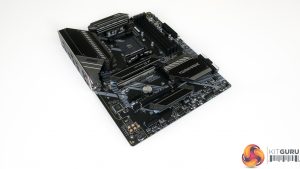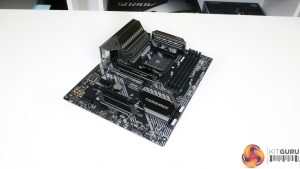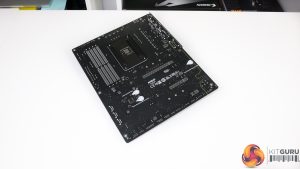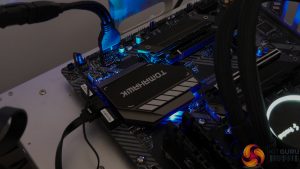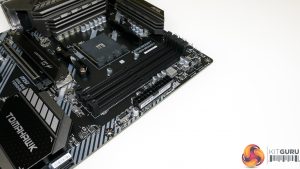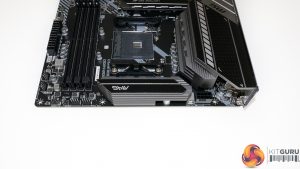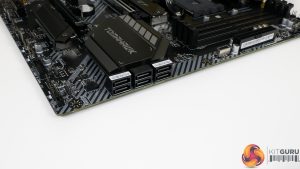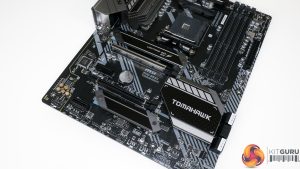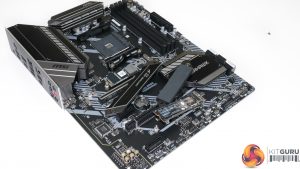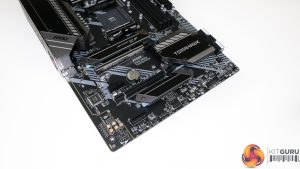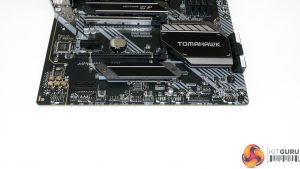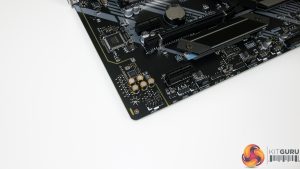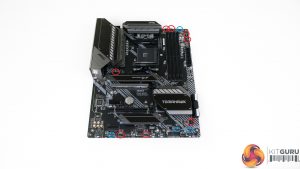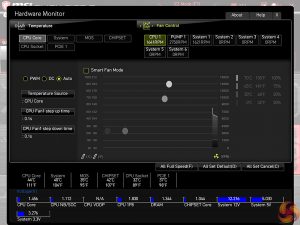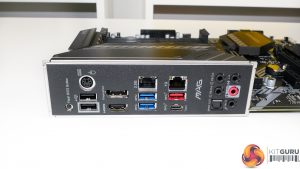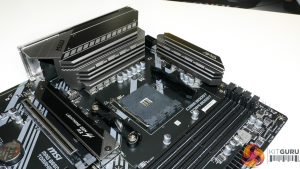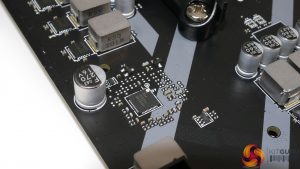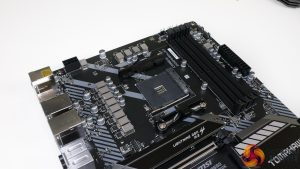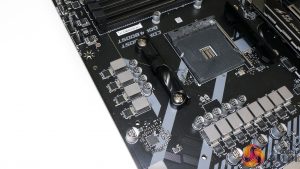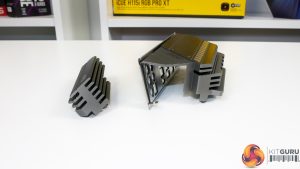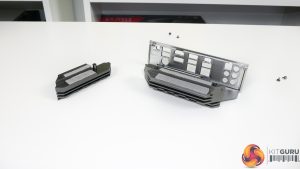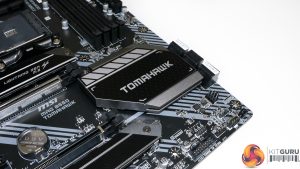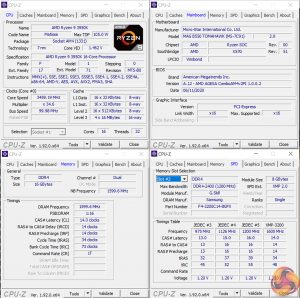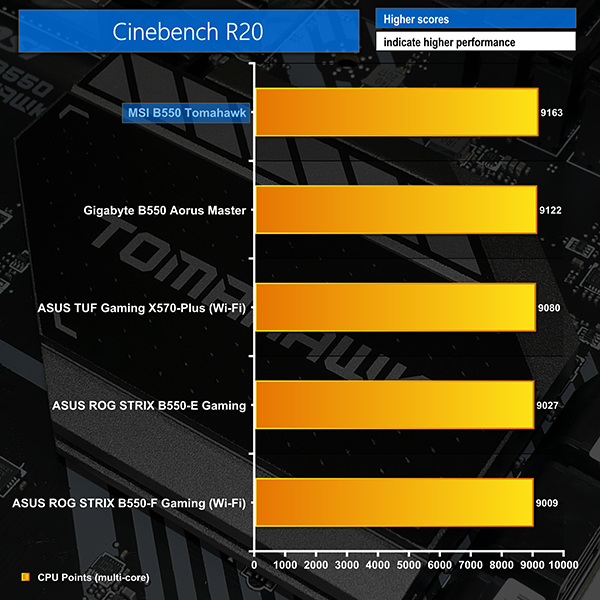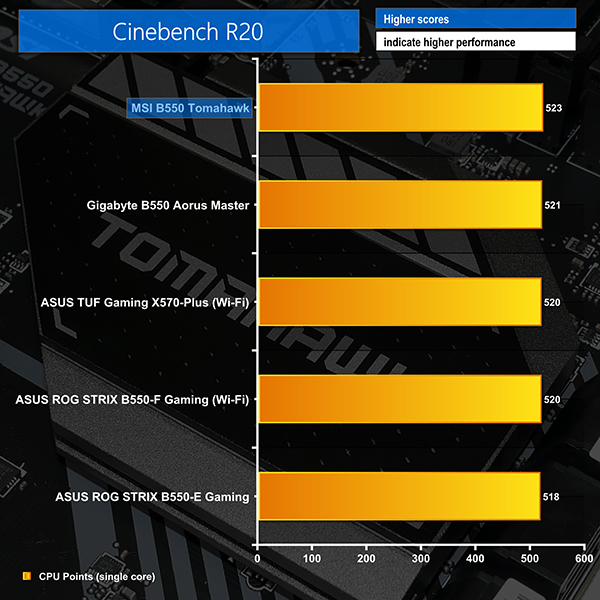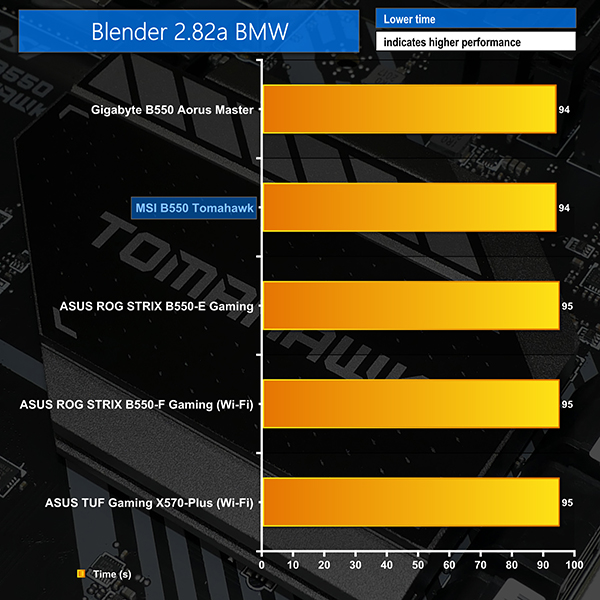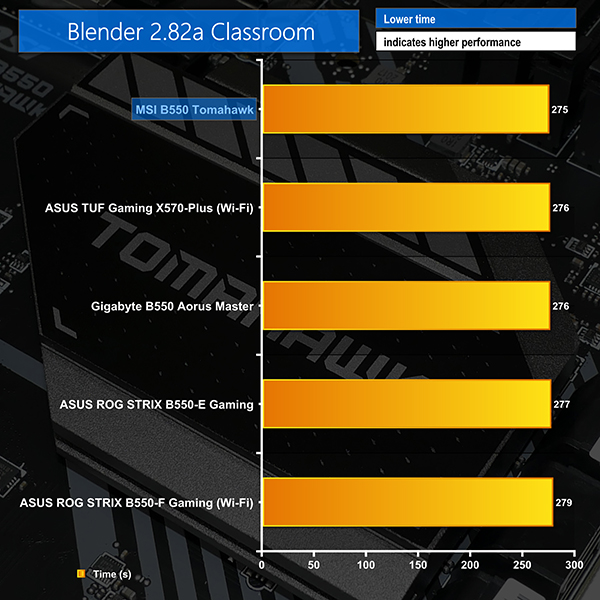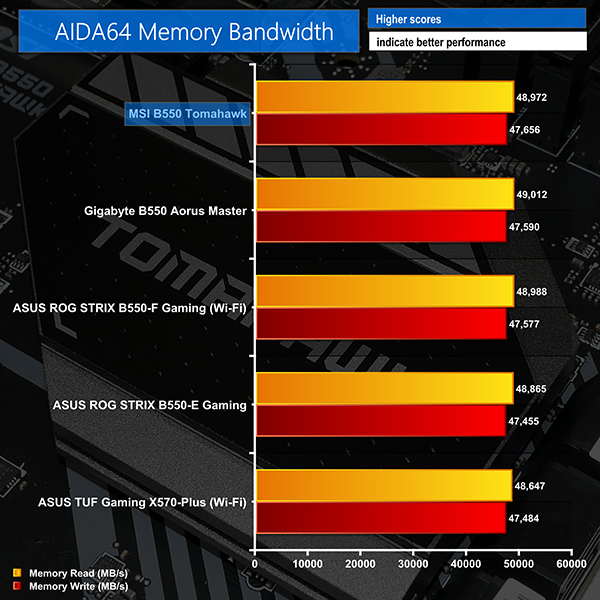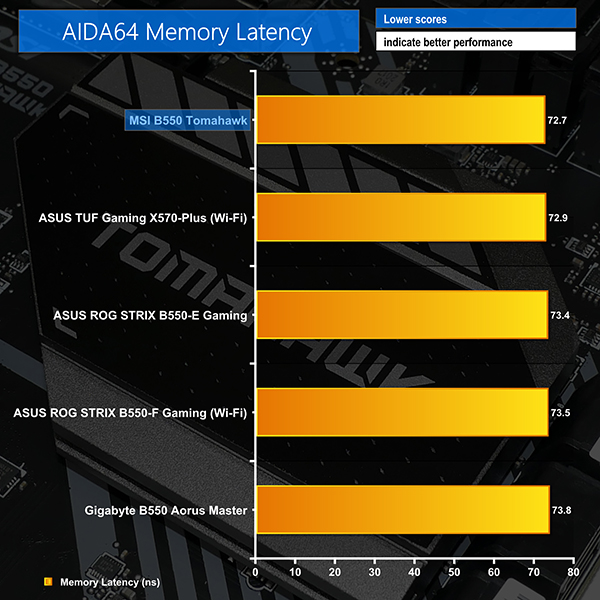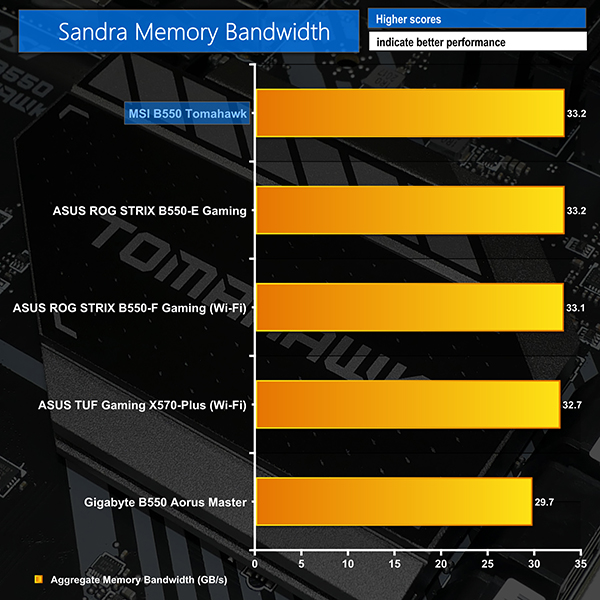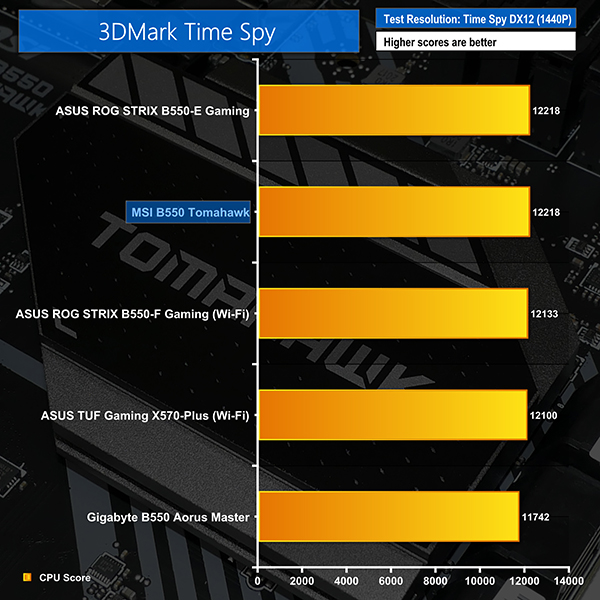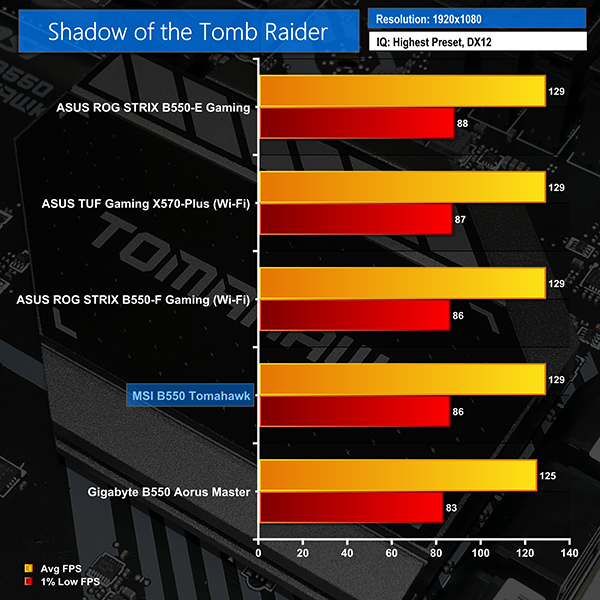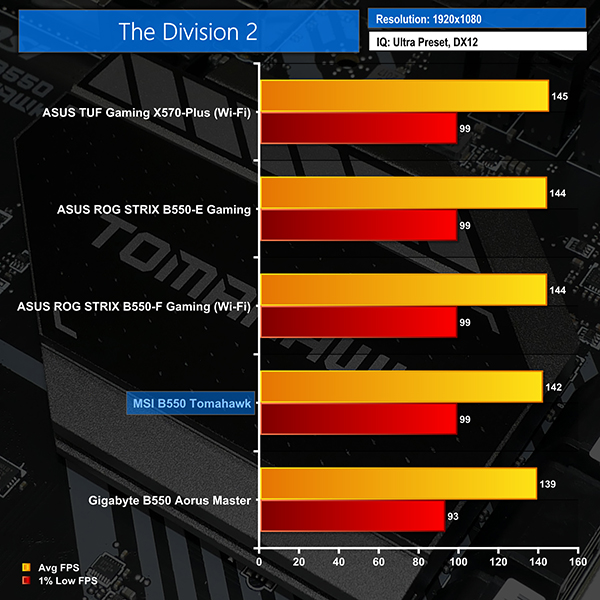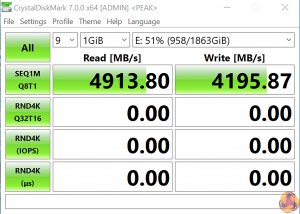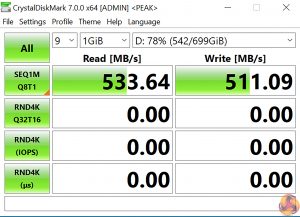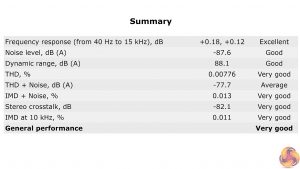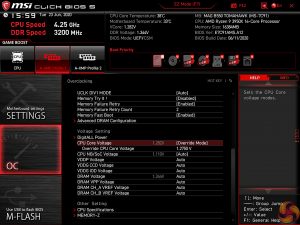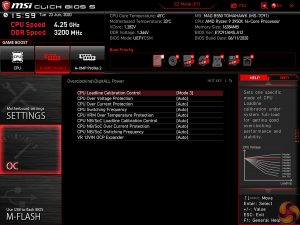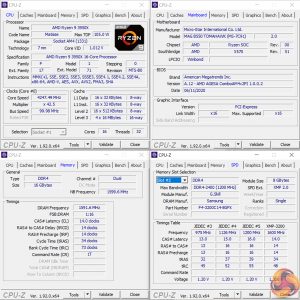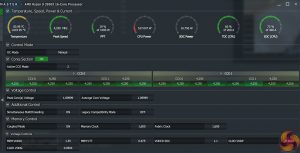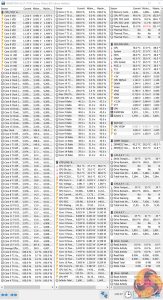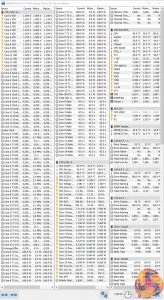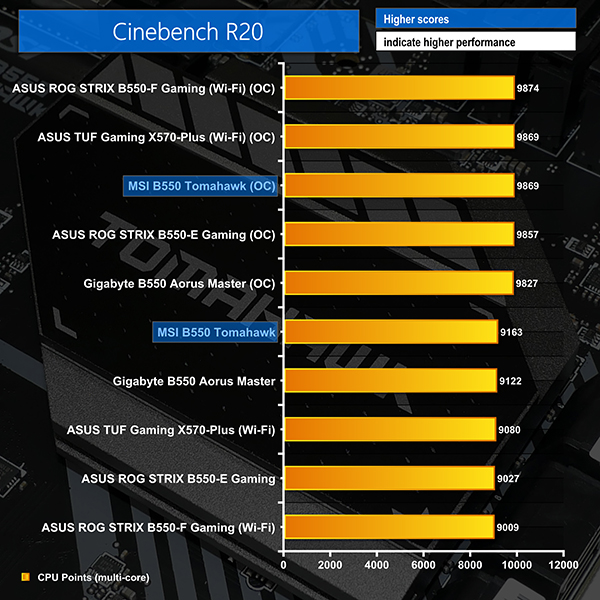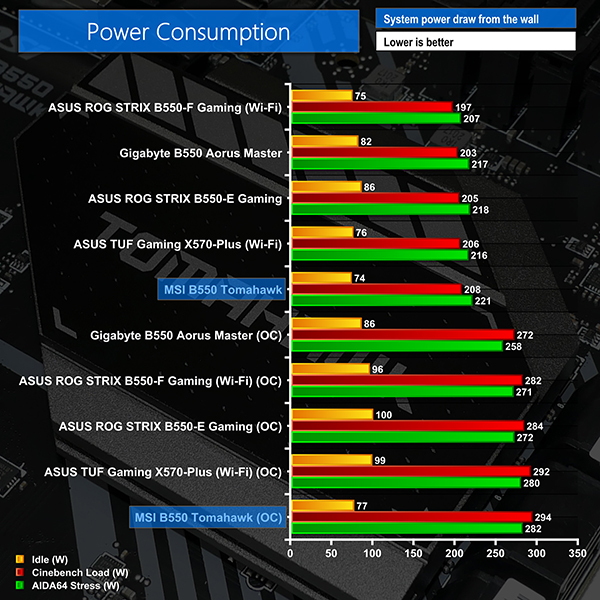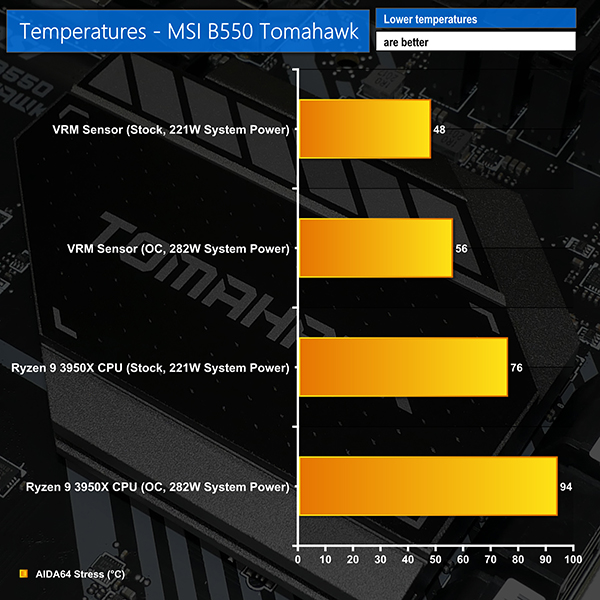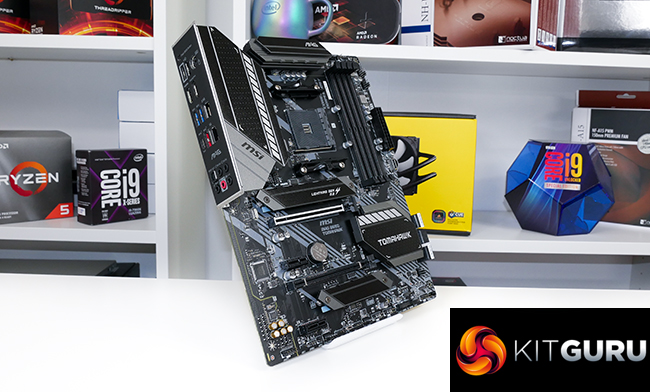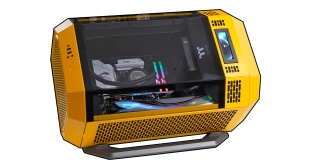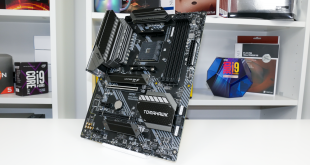
MSI’s Tomahawk motherboard SKUs have earned themselves legendary status amongst budget enthusiasts thanks to an ideal blend of features, performance, and pricing. Can the new MSI B550 Tomahawk continue the trend?
The core ‘Tomahawk trend’ is the focus for MSI’s MAG B550 Tomahawk. Central to the motherboard is its 10+2+1 stage power delivery solution with beefy metal heatsinks. MSI adds on valuable features such as cooling strips for both M.2 slots, a 2.5 Gigabit networking connection, and eight 4-pin fan headers.
These core features are clear signs that MSI is opting for the no-nonsense approach with the B550 Tomahawk by preferring solid core components over flashy lights. That is not to say that RGB is completely omitted – you get four headers and a touch of lighting beneath the chipset.
Can the Tomahawk SKU once again prove its value by offering B550 buyers a well-balanced motherboard with the correct set of features?
Specification
- Model Name: MAG B550 TOMAHAWK
- CPU Support: 3rd Gen AMD Ryzen™ processors and future AMD Ryzen™ processors with BIOS update
- CPU Socket: AMD Socket AM4
- Chipset: AMD B550 Chipset
- Graphics Interface: 1x PCI-E 4.0 x16 slot, 1x PCI-E 3.0 x16 slot, Support 2-way AMD CrossFire™ Technology
- Display Interface: DisplayPort, HDMI – Requires Processor Graphics
- Memory Support: 4 DIMMs, Dual Channel DDR4-4866+(OC)MHz
- Expansion Slots: 2x PCI-E 3.0 x1 slots
- Storag:e 2x M.2 slots, 6x SATA 6Gb/s SATA RAID Supports RAID 0, RAID 1 and RAID 10 for SATA storage devices
- USB Ports: 2x USB 3.2 Gen 2 10Gbps (1 Type-C + 1 Type-A), 5x USB 3.2 Gen 1 5Gbps (1 Type-C + 4 Type-A), 6x USB 2.0
- LAN: Realtek® RTL8125B 2.5G LAN, Realtek® RTL8111H Gigabit LAN
- Audio: 8-Channel(7.1) HD Audio with Audio Boost(ALC1200)
MSI includes a basic bundle with the B550 Tomahawk. You get a couple of SATA cables, screws for the M.2 slots, a case sticker, and the usual documentation.
The MSI B550 Tomahawk follows MSI’s usual styling for this SKU. A large swathe of black, dark grey, and silvers form the colour scheme and there are no real contrasting elements. I personally like the board’s styling.
Most notable when looking at the motherboard are the sizable VRM heatsinks – one of which doubles up as the rear IO cover.
There is nothing fancy on the rear as MSI does not opt for a backplate. That is a good decision for keeping costs down.
The PCB is a 6-layer design, which is a positive sign of quality.
You get a subtle RGB glow from beneath the chipset heatsink.
MSI’s QVL highlights support for a DDR4 memory kit as high as 5100MHz. The four DIMM slots can take up to 128GB of system memory.
I am very pleased to see MSI including an internal USB Type-C front panel header as many competing solutions around this price point omit the important connection. There is a caveat, however; MSI routes this port with a 5Gbps USB 3.0 link rather than the higher speed 10Gbps USB 3.2 Gen 2 alternative we are more used to.
Going for a 5Gbps USB connection is actually quite common at this price point and I am happy with decision. It is preferable to have the 10Gbps ports on the rear IO rather than the internal header when MSI is choosing between one or the other.
Four individual POST LEDs are useful for troubleshooting, but there is no 2-digit debug LED which is disappointing even at this price point. The lack of onboard power/reset/clear CMOS buttons is also slightly disappointing, but forgivable given the board’s pricing.
A single 8-pin CPU power connector is tucked away on the board’s corner thus making the cable easier to hide. We typically see 8+4-pin or 8+8-pin connectors on AM4 motherboards at this price point and above. However, I would be surprised if the single 8-pin on MSI’s B550 Tomahawk is inadequate for any of the current crop of Ryzen CPUs when overclocked sensibly.
A good set of fan headers are mounted in the top location but there is only a single RGB header – of the addressable variant – found in this region.
All six right-angled SATA connectors run directly from the B550 chipset. They do not share bandwidth with any other connections, making all six usable at any one time.
MSI outfits the B550 Tomahawk with dual M.2 slots, one of which supports drives up to 110mm long, with the other capable of housing 80mm variants as a maximum.
The top M.2 slot runs at up to PCIe Gen 4 x4 bandwidth direct from the AMD CPU. The bottom slot runs at up to PCIe Gen 3 x4 bandwidth using lanes from the B550 chipset. When installing an SSD in the bottom slot, it is critical to be aware of the CPU-to-chipset maximum link speed of PCIe Gen 3 x4 if you are also pushing data through other chipset-connected devices.
The bottom M.2 slot also shares bandwidth with the two PCIe slots above it and will drop to a PCIe Gen 3 x2 connection if the PCIe x1 slot above is used. This is far from ideal as speeds of modern SSDs can easily saturate a PCIe Gen 3 x2 connection.
Both M.2 slots are afforded a metal strip heatsink with thermal pad. This is a positive as we often see motherboard vendors dropping down to a single M.2 heatsink to save a few pennies at this price point.
A single steel-reinforced, full-length slot uses the CPU’s PCIe Gen 4 lanes to feed an x16 graphics card. The other full-length PCIe slot is fed by a PCIe Gen 3 x4 connection from the B550 chipset. The two PCIe x1 slots are also fed by the B550 chipset.
As we noted previously, the full-length PCIe Gen 3 x4 slot and the uppermost PCIe Gen 3 x1 slot share bandwidth with the lower M.2 connection. When the x1 slot is used, the M.2 connection drops to PCIe Gen 3 x2 link speed and the full-length PCIe slot is rendered unusable. Equally so, when an M.2 SSD is installed in the bottom slot, the full-length PCIe slot is completely unusable.
This is a bad PCIe layout design decision from MSI. It would have been far better for the PCIe or M.2 slots to share lanes with two of the SATA ports, as we see on competing solutions even at this price point.
Currently, the maximum high-bandwidth capability for the B550 Tomahawk is a Gen 4 x16 GPU, a Gen 4 x4 SSD, and a Gen 3 x4 M.2 SSD or PCIe add-in-card. Competing solutions can do Gen 4 x16 GPU, Gen 4 x4 SSD, Gen 3 x4, PLUS a Gen 3 x4 PCIe card.
If you want to install more than two M.2 SSDs alongside your graphics card, or if you’d like two M.2 SSDs plus a high-bandwidth capture card or similar, the MSI B550 Tomahawk cannot do that. MSI’s design decisions were poor and competing motherboards at this price point have better alternative lane allocation approaches.
Dual USB 2.0 headers are found on the board’s bottom edge. This is ideal for users with smart AIO coolers in addition to RGB controllers and card readers or the likes. You get a single USB 3.0 5Gbps internal header front panel duties.
And a couple more 4-pin fan headers, as well as three RGB headers, are provided in addition to the usual interfaces.
MSI’s audio system is built around the Realtek ALC1200 audio codec, rather than the higher-end, more common ALC1220 that we typically see deployed. Nippon Chemicon audio capacitors are used, in addition to dedicated PCB tracks.
Eight total 4-pin fan headers are provided with the B550 Tomahawk. This is a superb number for any motherboard, never mind one at this price point. The distribution of fan headers is also very good, with five being within easy reach of the CPU socket, and three in the board’s lower quadrant.
You get four RGB headers on the board in total – one addressable in the top-right, one 4-pin 12V in the bottom left, and one 4-pin 12V plus one addressable in the bottom right. Four RGB headers is common and good to see. However, I personally find the installation approach of placing two near the top of the board and two near the bottom of the board to be superior for cable routing.
It is also slightly disappointing to see that some of the headers are not positioned directly on the edge of the motherboard. This is most notable with two of the lower RGB headers and will force users to trail cables over a small amount of PCB, rather than tuck them through chassis grommets with minimal untidiness on display.
MSI deserves credit for implementing a strong fan control solution through the UEFI. You get the ability to control fan speeds via a 4-point curve, and it is positive to note that the 0 RPM speed mode generally works.
The speed hysteresis settings and ability to drive curves from different temperature sensor data also deserves credit and will please many users.
Dual USB 2.0 ports are installed on the rear IO, one of which is also allocated BIOS Flashback duties. MSI includes a PS/2 keyboard/mouse port which, in today’s market, is rather pointless in my opinion and would be better replaced with a couple more USB 2.0 ports.
You also get a couple of 5Gbps USB 3.0 Type-A ports and two 10Gbps USB 3.2 Gen 2 ports fed by the AMD CPU, one of which is Type-C. I would have liked to see more Type-A USB ports as a total of five will be inadequate for some users and there is plenty of bandwidth and rear IO spacing spare.
MSI bolsters the usual 1Gb Ethernet connection, which uses a Realtek RTL8111H controller, by adding a Realtek RTL8125B-powered 2.5 Gigabit LAN port. This is good to see as 2.5GbE is becoming commonplace on B550 offerings. Dual NICs will also appeal to some users who may run a direct 2.5GbE connection to their NAS or server whilst using the 1GbE connection for all other internet and network traffic.
The usual set of audio connectors, including SPDIF optical is used. A rear clear CMOS button is missed, but this is somewhat forgivable at this price point.
MSI deploys a 4K60-capable DisplayPort connection for use with Ryzen APUs. Unfortunately, the HDMI port only seems to be version 1.4b as MSI repeatedly advertises its 4K resolution support at below 60Hz (24Hz or 30Hz). This is highly disappointing and really is completely unacceptable on a B550 motherboard of this calibre and at this price point. The future Zen 2-based APUs are looking to be compelling options (hopefully), so it is not unreasonable to think that a B550 Tomahawk buyer will want to run a 4K60 connection to their TV or monitor from their APU. Unfortunately, they cannot officially do that without HDMI 2.0 support.
As a note, this is the first B550 motherboard that I have seen to not offer a 4K60-capable HDMI 2.0 port. Very disappointing, and completely unnecessary from MSI!
MSI uses a 10+2+1 power stage design for the B550 Tomahawk that is split as 10 stages for the CPU, 2 stages for the SoC, and 1 stage for the APU graphics.
The PWM controller used is a Renesas 229004. As MSI does not use phase doublers, the PWM controller is operating in 5+2 phase control mode. This highlights that MSI is using a teamed/parallel power stage design whereby one PWM control phase handles two physical power stages. This is a common solution in today’s motherboard market that we see deployed regularly on ASUS motherboards in particular.
Ten Intersil ISL99360 smart power stages are used to feed the AM4 CPU. These are rated at up to 60A current output and are highly regarded, quality solutions. The SoC’s 2 power stages are also Intersil ISL99360 units.
In terms of raw hardware, MSI’s B550 Tomahawk looks to have a capable and robust power delivery solution for AM4. We are not expecting any power delivery concerns with the Renesas/Intersil hardware.
The large left-side VRM heatsink doubles as the rear IO cover in order to increase its bulk. This is a net positive from a cooling perspective. The heatsink design is certainly not very efficient as there is very little effort to fin the structure and drastically increase its surface area. However, the sheer bulk and mass of the metal heatsink, combined with the quality power stages deployed, means that it is likely to be a well-cooled implementation.
The upper VRM heatsink is also not particularly optimised as far as heatsink design goes. It is also not connected to the large VRM block via heatpipe, so must handle its cooling duties on its own. MSI makes a smart design move, however, by deploying only two of the CPU’s ten power stages beneath the smaller MOSFET heatsink (plus two of the less-stressed SoC power stages). This means that the smaller top VRM heatsink will be expected to handle a far smaller thermal load. I like this simple design tweak by MSI and consider it to be smart.
Another minor design point that is good to see if the use of a thermal pad to contact the chokes. Realistically, the chokes do not need to be cooled by the VRM heatsink. But there is no harm in connecting them with the large blocks of metal to provide some additional cooling capacity, if required.
The chipset heatsink is a simple block of metal that is styled for aesthetic benefits. As the B550 chipset does not need a sizable amount of cooling, this design looks to be perfectly adequate.
Another task of the chipset heatsink is to sit above the RGB LEDs mounted directly beneath.
For more details on MSI’s UEFI and OS software offering, check out our previous MSI AM4 motherboard review HERE.
We will be outlining the MSI MAG B550 Tomahawk motherboard’s performance with the AMD Ryzen 9 3950X CPU, 16GB of 3200MHz DDR4 memory, and an Aorus RTX 2080 Ti graphics card.
AM4 Motherboard Test System:
- Processor: AMD Ryzen 9 3950X.
- Memory: 16GB (2x8GB) G.SKILL 3200MHz CL14 DDR4 @ 1.35V.
- Graphics Card: Gigabyte Aorus RTX 2080 Ti XTREME (custom fan curve to minimise thermal throttling).
- System Drive: WD_Black SN750 PCIe 3.0 x4 NVMe M.2 SSD.
- Games and Test SSD: Crucial MX300 750GB & Aorus 2TB PCIe Gen 4 M.2 SSD.
- CPU Cooler: Fractal Celsius+ S28 Prisma 280mm AIO (full speed fans and pump to eliminate thermal throttling).
- Power Supply: Seasonic Prime TX-1000 1000W.
- Case: Lian Li Open-air Test Bench.
- Operating System: Windows 10 Pro 64-bit.
BIOS Version:
- MSI MAG B550 Tomahawk (AGESA ComboAM4v2PI 1.0.0.2) [Latest at the time of testing]
Comparison Motherboards:
- ASUS ROG STRIX B550-E Gaming (AGESA 1.0.0.1)
- ASUS ROG STRIX B550-F Gaming (WiFi) (AGESA 1.0.0.1)
- Gigabyte B550 Aorus Master (AGESA ComboAM4v2 PI 1.0.0.1)
- ASUS TUF Gaming X570-Plus (Wi-Fi) (AGESA Combo-AM4 1.0.0.4)
Tests:
- Cinebench R20 – All-core & single-core CPU benchmark (CPU)
- Blender 2.82a – All-core rendering of the BMW and Classroom benchmarks (CPU)
- SiSoft Sandra – Memory bandwidth (Memory)
- AIDA64 – Memory bandwidth, memory latency (Memory)
- 3DMark TimeSpy – Time Spy (1440p) test (Gaming)
- Shadow of the Tomb Raider – 1920 x 1080, Highest quality preset, no AA, DX12 version (Gaming)
- Tom Clancy's The Division 2 – 1920 x 1080, Ultra quality preset, no AA, DX12 version (Gaming)
- CrystalDiskMark– Storage transfer rates (Motherboard)
- Rightmark Audio Analyzer 6.4.5 – Record and playback test using a line-in to line-out loopback with a 3.5mm audio cable (Motherboard)
- AIDA64 – Stress test (Temperatures & Power Consumption)
- HWiNFO – System sensor monitoring during stress test (Temperatures & Power Consumption)
Cinebench R20
Blender Benchmark
CPU-based performance from the MSI B550 MAG Tomahawk is very good. A number of chart-topping results are put forward, with MSI aided by the very recent AGESA update.
All-core and single-core boost clocks functioned as expected. Ryzen 9 3950X clock speed after an hour of AIDA all-core loading was 4000MHz.
AIDA64 Engineer
Sandra Memory Bandwidth
Another set of chart-topping results is shown in the memory tests. MSI’s board performs well on both the bandwidth and latency fronts. Again, the latest AGESA update helps significantly.
3DMark
3DMark is a multi-platform hardware benchmark designed to test varying resolutions and detail levels of 3D gaming performance. We run the Windows platform test and in particular the Time Spy benchmark, which is indicative of high-end 1440p PC Gaming.
Shadow of the Tomb Raider
We use the DirectX 12 mode, anti-aliasing disabled, and the Highest quality preset.
Tom Clancy's The Division 2
We run the game with quality set to Ultra, VSync disabled, and DX12 mode.
Gaming performance is solid, and the Tomahawk shows no sign of head-scratching weaknesses. ASUS’ competitors are consistently faster by small margins, but the MSI B550 MAG Tomahawk holds its own against the Gigabyte B550 Aorus Master.
M.2 PCIe Performance
We test M.2 PCIe performance using an Aorus PCIe Gen 4 2TB SSD. This SSD uses a Phison-based PCIe Gen 4 controller.
M.2 performance is at the level we expect, with the read result coming in at just below 5GBps. Of course, any M.2 SSD installed in the chipset-connected slot will be limited to PCIe Gen 3 x4 bandwidth and any CPU-to-chipset link speed restrictions.
Thermal performance from the metal M.2 heatsink was good enough to keep our drive adequately cooled. MSI’s offering was not quite as thermally efficient as the ASUS competitors’ version though.
SATA 6Gbps Performance
For SATA 6Gbps testing we use a Crucial MX300 750GB SSD.
SATA 6Gbps performance from the B550 chipset ports is as expected.
Audio
Rightmark Audio Analyser is a freeware benchmarking utility designed to objectively test the performance characteristics of audio solutions. We setup a line-in line-out loop and execute the record/playback test before generating the results report you see below. A sampling mode of 24-bit, 192 kHz was tested.
Despite using the lower-end Realtek ALC1200 audio codec, compared to the common ALC1220, MSI’s B550 MAG Tomahawk delivers ‘Very Good’ overall audio performance. This is according to the Rightmark Audio Analyzer test procedure.
Manual CPU Overclocking:
To test the MSI MAG B550 Tomahawk motherboard’s CPU overclocking potential, we set the CPU Core Voltage to 1.275V and applied the Mode 3 LLC setting.
Manual overclocking is quick and easy thanks to the straightforward MSI UEFI and clear loadline calibration settings.
The usual 4.25GHz overclock of our Ryzen 9 3950X 16-core CPU was achieved. Typically, we opt for 1.3V but the MSI motherboard was better set with 1.275V and Mode 3 LLC. This delivered around 1.26V under heavy load – a similar level to the competing B550 offerings.
Motherboard Sensors
Temperature sensors including a MOSFET reading are fed through to monitoring tools such as HWiNFO64. The VRM MOSFET temperature reading is particularly good to see and we found its accuracy to be good when compared against manual readings.
Overclocked Performance
Pushing the CPU to 4.25GHz delivers a strong performance improvement for the Tomahawk when stressed with an all-core load.
System Power Consumption
We leave the system to idle on the Windows 10 desktop for 10 minutes before taking a reading. For CPU load results we run AIDA64 CPU, FPU, and Cache stress tests and take a reading. The power consumption of our entire test system (at the wall) is shown in the chart.
MSI’s B550 MAG Tomahawk could certainly use a small improvement to voltage tweaking at stock conditions, as indicated by the higher power consumption levels.
Overclocked power draw numbers were also higher than on competing motherboards, but this is primarily tied to differing voltage and LLC settings rather than specific VRM inefficiencies.
MSI’s powerful VRM solution is more than capable of handling our overclocked 16-core chip with relative ease.
System Temperatures
We run the AIDA64 CPU stress test for 1 hour while recording the system data using HWInfo. This data is then analysed to show the CPU temperatures and also the VRM temperatures. Ambient was around 25-27°C.
Stock-clocked temperatures were fine for the CPU, despite MSI pushing a little more power through the system than competitors. The VRM heatsink clearly performs well with hefty cooling loads – we did not see the MOSFET sensor rise above 48C even with an hour of stress testing in a hot ambient environment.
Turning up the heat by applying a CPU overclock leads to increased VRM temperatures, but MSI’s sizable heatsink still manages to tame the thermal load with relative ease. I am very impressed by the MSI B550 MAG Tomahawk motherboard’s ability to cool its power delivery system.
The MSI MAG B550 Tomahawk does well to offer a solid balance of features, good cooling capability, and strong overall performance. This blend of positives is likely to appeal to many prospective buyers, particularly as the notable shortcomings are of minor importance.
Performance was excellent at stock conditions. Overclocking numbers were also positive, and it was easy to push our 16-core chip to 4.25GHz thanks to MSI’s simple UEFI and clear LLC settings.
MSI’s deployed 10-stage CPU power delivery solution worked without hiccup throughout our testing. And the oversized VRM heatsinks, while not particularly efficient in their design, did a superb job at cooling the high-quality power stages beneath.
It was also pleasing to report that both M.2 slot were allocated metal heatsinks with thermal pads. The internal USB Type-C front panel header was another pleasing point. And MSI’s focus on ample fan headers and excellent UEFI-based control is a major positive.
There are some clear downsides for the B550 Tomahawk, though. MSI’s chosen PCIe/M.2 lane allocation is poor and is clearly inferior to competing solutions even at this price point. In fact, if you want to run dual M.2 SSDs plus a high-bandwidth add-in-card, or triple M.2 SSDs, you cannot. A more minor negative is the inclusion of ‘only’ five Type-A USB ports on the rear. We think it would have been better to include a couple more rather than the (useless?) PS/2 combo port.
And the other major negative is the HDMI connection. All of MSI’s documentation points to the HDMI port being version 1.4b rather than version 2.0 or 2.1 that we see on motherboards from competing vendors. This is highly disappointing as it means that APUs users with this motherboard cannot do 4K60 output to their TV or HDMI monitor. I really do have absolutely no clue why MSI would think that this is an appropriate design move. It shows a lack of attention to detail that is not commonly associated with the company’s Tomahawk SKUs.
In terms of market positioning and competition, the £179.99 MSI B550 Tomahawk goes up against the ASRock B550 Steel Legend and ASUS TUF-Gaming B550-Plus. The ASRock alternative is a particularly tough competitor as it offers a similar feature set but does not include some of the silly design moves taken by MSI on the B550 Tomahawk.
With that said, the MSI B550 Tomahawk is undeniably strong from a power delivery and VRM cooling perspective. Plus, the inclusion of dual NICs, one of which is 2.5Gb, will appeal to many prospective buyers. And the deployment of eight 4-pin fan headers with superb control capabilities are further points that make the MSI B550 Tomahawk an appealing solution.
The MSI MAG B550 Tomahawk is priced at £179.99 at Overclockers UK.
Discuss on our Facebook page HERE.
Pros:
- Strong power delivery solution.
- Good VRM cooling and MOSFET temperature sensor.
- 2.5 Gigabit Ethernet plus 1 Gigabit Ethernet.
- USB Type-C front panel header.
- Dual cooled M.2 slots.
- Eight 4-pin fan headers with good speed control.
- Easy-to-use UEFI with clear overclocking and LLC settings.
Cons:
- PCIe and M.2 lane allocation is not as good as competitors.
- HDMI port does not do 4K60.
- Onboard 2-digit debug LED and Clear CMOS button would have been welcomed.
KitGuru says: Good power delivery capabilities, an excellent fan header and control subsystem, and strong performance make the MSI MAG B550 Tomahawk a promising choice, provided you are happy with the HDMI and PCIe/M.2 limitations.
Be sure to check out our sponsors store EKWB here
 KitGuru KitGuru.net – Tech News | Hardware News | Hardware Reviews | IOS | Mobile | Gaming | Graphics Cards
KitGuru KitGuru.net – Tech News | Hardware News | Hardware Reviews | IOS | Mobile | Gaming | Graphics Cards


